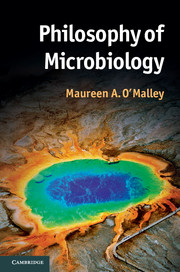Book contents
- Frontmatter
- Contents
- List of figures and tables
- Acknowledgements
- An introduction to philosophy of microbiology
- Chapter 1 Philosophy in microbiology; microbes in philosophy
- Chapter 2 Philosophical debates in high-level microbial classification
- Chapter 3 Philosophical debates in species-level microbial classification
- Chapter 4 Philosophical issues in microbial evolution
- Chapter 5 Microbial ecology from a philosophical perspective
- Chapter 6 Microbes as model biological systems
- Conclusion: further philosophical questions
- Glossary
- References
- Index
Conclusion: further philosophical questions
Published online by Cambridge University Press: 05 September 2014
- Frontmatter
- Contents
- List of figures and tables
- Acknowledgements
- An introduction to philosophy of microbiology
- Chapter 1 Philosophy in microbiology; microbes in philosophy
- Chapter 2 Philosophical debates in high-level microbial classification
- Chapter 3 Philosophical debates in species-level microbial classification
- Chapter 4 Philosophical issues in microbial evolution
- Chapter 5 Microbial ecology from a philosophical perspective
- Chapter 6 Microbes as model biological systems
- Conclusion: further philosophical questions
- Glossary
- References
- Index
Summary
This chapter will end the book by addressing some broad questions that arise from the more detailed discussions in previous chapters. These questions have to do with life: how microbiology puts human life into a broader biological context, what life is, and how the study of life could and should be understood by philosophy of biology.
Putting human life into a microbial context
The previous chapters have emphasized a ‘continuity of life’ perspective that sees all living things as sharing many common capacities. Living entities can be examined within shared scientific frameworks for classification, evolution and ecology, even as this common treatment enables an understanding of major differences between diverse forms of life. There is no need in this loose way of thinking about life to invoke anything such as vitalism, but there is a requirement to understand the physical processes, geology and chemistry that contribute to the origin and evolution of living things. However, despite this unobjectionable continuity view, there is still a tendency amongst philosophers and scientists to perceive humans as special – as something biologically, socially and culturally more extraordinary than the rest of life.
- Type
- Chapter
- Information
- Philosophy of Microbiology , pp. 201 - 218Publisher: Cambridge University PressPrint publication year: 2014



